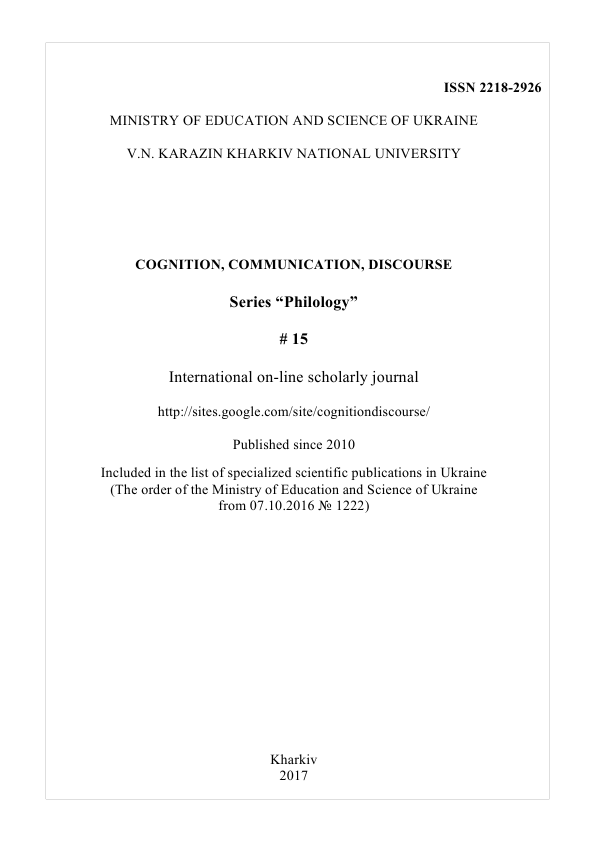Mytholoric space of Amerindian prosaic texts: cognitive-semiotic and narrative perspectives
Abstract
The paper suggests a new cognitive facet of ethnolinguistics for exposing ethno-cultural features embodied in mytholoric characters of literary prosaic texts. The term "mytholoric" is a coinage that reflects syncretic unity of mythic and folk lore of Amerindian culture. Myhtoloric space is defined as cognitive and semiotic construct that incorporates different types of mytholoric characters. Author’s mytholoric character is a cumulative cognitive and semiotic textual construal, which reflects behavior and deeds of the person who stands for the interests of Amerindian in modern American society and tries to adapt to the rules of existing in that new world. It has been proved that metamorphosis is a dominant linguistic means in creating mytholoric and author’s mytholoric character. Semiotic and cognitive analysis made it possible to construe the model of the main character, interpreted as ethnocultural symbol. Narrative analysis of the Amerindian prosaic texts outlined the ways and means of narrative perspectives highlighting metamorphosis and reverse perspective as the major ones in creating and interpreting the mytholoric space in literary text. The paper suggests linguistic and cognitive mechanism of reverse perspective in literary text. Models of mytholoric space are determined by the genre of the literary text and eclecticism of mytholoric characters.Downloads
References
Barthes, R. (1975). The Pleasure of The Text. New York: Hill and Wang.
Bruner, E.M. (1986). Introduction. In: V.W. Turner, & E.M. Bruner (Eds.). The Anthropology of Experience (p. 7). Urbana: University of Illinois Press.
Florensky, P. (2002). Reverse Perspective. London: Reaction Books.
Freeman, M.H. (2007). Poetic iconicity. In: V. Chlopicki, A. Pawelec, & A. Pokojska (Eds.).Cognition in language.Volume in honour of Professor Elzbieta Tabakowska (pp. 472–501). Krakow: Terrium.
Genette, G. (1980). Narrative Discourse: an Essay in Method. New York: Cornell University Press.
Jacobson, R., & Halle, M. (1975). Fundamentals of Language. The Hague-Paris: Mouton.
Jung, C.G. (1964). Man and His Symbols. New York: Anchor Press.
Lake-Thom, B. (1997). Spirits of the Earth: a Guide to Native American Nature Symbols, Stories and Ceremonies. New York: Penguin Group.
Langacker, R. (1990). Concept, image and symbol. Berlin-New York: Mouton de Gruyter.
Lincoln, K. (1985). Native American renaissance. California: University of California Press.
Lundquist, S. (2004). Native American literatures: An introduction. New York-London: Continuum International Publishing Group.
Macmillan English Dictionary for Advanced Learners (2002). Oxford: Bloomsbury Publishing.
Martin, B., & Ringham, F. (2006). Key Terms in Semiotics. London: Continuum.
Sandner, D. (1991). Navajo Symbols of Healing. Rochester: Healing Arts Press.
Schmid, W. (2003). Narratology: An Introduction. Berlin-Boston: de Gruyter.
Silverman, K. (1983). The Subject of Semiotics. New York: Oxford University Press.
Toelken, B. (1976). Seeing with a Native Eye: How Many Sheep Will It Hold. New York: Harper and Row.
Volkova, S.V. (2016). Semiotics of Butterfly in Modern Amerindian Prose. Science and education a new dimension. Philology, 4(50), 46–51.
Volkova, S.V. (2016). Reverse Perspective as a Narrative Technique in Amerindian Prosaic Texts. Legeartis. Language yesterday, today, tomorrow, 1(1), 359–394, DOI: 10.1515/ lart-2016-0008.
Volkova, S.V. (2017). The Semiotics of Folkdance in Amerindian Literary Prose. In: E.Chrzanowska-Kluczewska, & O. Vorobyova (Eds.). Language – Literature – the Arts: a Cognitive Semiotic Interface (pp. 149–166). Frankfurt am Main et al.: Peter Lang Edition.
Authors, who publish with this journal, accept the following conditions:
The authors reserve the copyright of their work and transfer to the journal the right of the first publication of this work under the terms of the Creative Commons Attribution License (CC BY), which allows other persons to freely distribute a published work with mandatory reference to the authors of the original work and the first publication of the work in this journal.
Authors have the right to enter into separate additional agreements for the non-exclusive dissemination of the work in the form in which it was published by this journal (for example, to post the work in the electronic institutions' repository or to publish as part of a monograph), provided that the link to the first publication of the work in this journal is given.
The journal policy allows and encourages the authors to place the manuscripts on the Internet (for example, in the institutions' repositories or on personal websites), both before the presentation of this manuscript to the editorial board and during review procedure, as it contributes to the creation of productive scientific discussion and positively affects the efficiency and dynamics of citing the published work (see The Effect of Open Access).




